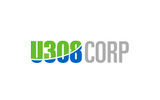U308 Corp. Reports. 23% Improvement in Vanadium Extraction Over the 2014 Preliminary Economic Assessment on its Laguna Salada Uranium-Vanadium Deposit
posted on
Dec 06, 2018 10:11AM

Edit this title from the Fast Facts Section

|
U3O8 Corp. Reports a 23% Improvement in Vanadium Extraction Over the 2014 Preliminary Economic Assessment on its Laguna Salada Uranium-Vanadium Deposit
|
|
Toronto, Ontario, December 6, 2018 - U3O8 Corp. (TSX: UWE), (OTCQB: UWEFF) ("U3O8 Corp." or the "Company") is pleased to report initial results of test work on the extraction of uranium and vanadium from almost a metric tonne of mineralized gravel from the wholly-owned Laguna Salada deposit in Argentina.
The test work has been designed, and results monitored, by Mr. David Marsh, director of U3O8 Corp. whom, as former General Manager - Technical Project Development at Paladin Energy, was intimately involved in the design, construction and operation of two uranium production plants in Africa. This work represents a complete overhaul of the preliminary economic assessment ("PEA") carried out by Tenova Mining and Minerals (Australia) Pty Ltd. in 2014. Mr. Marsh, with his vast practical experience, reviewed the PEA and felt that there was room for improvement and simplification of the flowsheet and processing plant design, resulting in potential to reduce estimated capital costs ("capex") and operating costs ("opex").
David Marsh commented, "I am delighted with the initial results from our test work on Laguna Salada gravel. The work program was designed to test ways of reducing estimated production costs by simplifying the former PEA process flow sheet. Our first step was to optimize the washing of the fine, uranium-vanadium - bearing material off the barren pebbles. The test results show that "scrubbing" the gravel for 5 minutes produces similar results as scrubbing for the 15 minutes modelled in the PEA. This two-thirds reduction in processing time could potentially reduce the cost of the associated equipment which was estimated at US$6.2 million in the PEA."
"Our second step aimed to extract more of the uranium and vanadium contained in the gravel, and this proved successful with vanadium recovery increasing by 23%, and uranium marginally by 2%, over the PEA."
The original Laguna Salada PEA reported life-of-mine cash costs of approximately US$22 per pound of uranium, net of vanadium, and a net present value of US$55 million at a 7.5% discount rate, with a US$136 million capital cost.
A PEA is preliminary in nature and includes inferred mineral resources that are considered too speculative geologically to have the economic considerations applied to them that would enable them to be categorized as mineral reserves, and there is no certainty that the results of the PEA assessment will be realized.
Next Steps:
There are two main components to ongoing metallurgical test work:
Technical Details of Test Work:
1. Bulk Sample
Approximately 950 kilograms of gravel was excavated from within three metres of surface from five locations within the resource footprint in the Guanaco sector of the Laguna Salada Deposit. Guanaco contains 94% of the total Laguna Salada resource tonnage (an Indicated and Inferred resource) and 87% of the contained Uranium. The material was bagged and shipped toAustralian Nuclear Science and Technology Organisation ("ANSTO") in Australia. The sample was homogenized prior to commencing the test work.
2. Test Work Aimed at Simplifying the Process Flow Sheet
Scrubbing at Laguna Salada refers to removal of fine uranium-vanadium - bearing powder that coats barren pebbles in the gravel. The scrubbed material was then screened to separate the pebbles from the fine component into which most of the uranium and vanadium is concentrated. The flowsheet generated for the PEA involved a gravel-scrubbing process followed by screens and cyclones to separate the extremely fine (0.075mm) material from the gravel, along with two stages of filtration ahead of the uranium/vanadium leach circuit. David Marsh commented, "There is scope to simplify the process flowsheet making the future plant easier to operate."
The recent work at ANSTO suggests that this circuit can be greatly simplified as follows:
Table 1. Summary of beneficiation and alkaline leach tests on <0.85mm material from a bulk sample of gravel from the Guanaco sector of the Laguna Salada Deposit.
 3. Alkaline Leach The alkaline leach was done at a temperature of 80 degrees Celsius (175 degrees Fahrenheit) for 8 hours and maximum extraction of 94% was achieved after 6 hours.
Technical Information & Cautionary Note
The technical report referred to in this press release is entitled:
September 18, 2014 technical report: "Preliminary Economic Assessment of the Laguna Salada Uranium Vanadium Deposit, Chubut Province, Argentina." The report is available on www.sedar.com and www.u3o8corp.com.
Dr. Richard Spencer, P.Geo., CGeol., President and CEO of U3O8 Corp. and a Qualified Person as defined by National Instrument 43-101, has approved the technical information in this news release relating to the Laguna Salada Deposit and the related PEA.
About U3O8 Corp.
U3O8 Corp. is focused on exploration and development of deposits of uranium and battery commodities in South America. Battery commodities that occur with uranium resources include vanadium, nickel, zinc and phosphate. The Company's mineral resources estimates were made in accordance with National Instrument 43-101, and are contained in the following deposits:
Additional Information
Information on U3O8 Corp., its resources and technical reports are available at www.u3o8corp.com and on SEDAR at www.sedar.com. Follow U3O8 Corp. on Facebook: www.facebook.com/u3o8corp, Twitter: www.twitter.com/u3o8corp and YouTube: www.youtube.com/u3o8corp.
For further information, please contact:
Carolina Diaz at carolina@u3o8corp.com or phone (416) 868-1491 or Richard Spencer, President & CEO, U3O8 Corp., Tel: (647) 292-0225 richard@u3o8corp.com
|